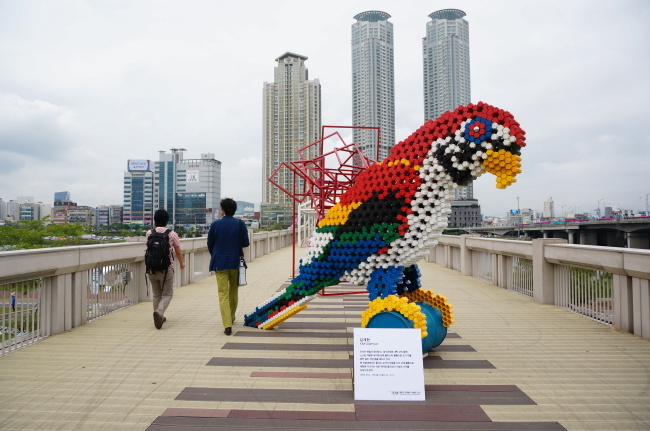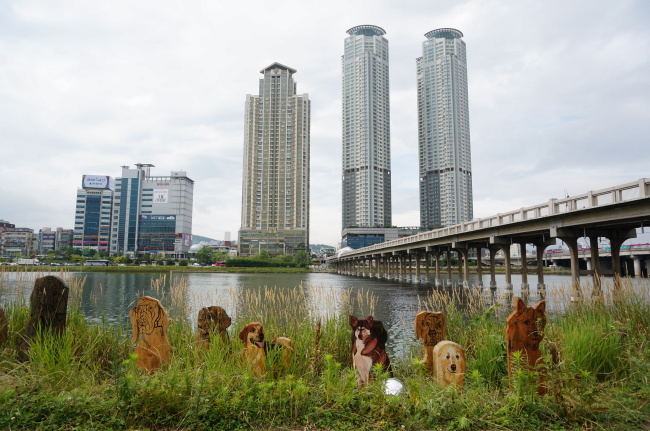Art struggles to find space in Ulsan
Manufacturing powerhouse seeks to shed image of industrial town with public art festival
By Lee Woo-youngPublished : June 15, 2014 - 20:18
ULSAN ― Every summer for the past eight years, art sculptures and installations popped up along the Taehwa River that cuts through this port city, home to the world’s largest automobile assembly plant and its largest shipyard.
But the Taehwa River Eco Art Festival seems to have had little impression on citizens of Ulsan, despite its stated aim of stimulating public interest in art.
“We’ve met opposition and complaints from citizens and local businesses in organizing the art festival. Even though it has been eight years since the festival started, it has failed to win hearts of citizens,” said Paek Dong-min, head of the festival’s organizing committee and publisher of Public Art magazine.
“The hardest part was convincing local business owners that the 12-day art festival is not an interruption to their business, but actually a benefit.”
This year’s art festival began Thursday and continues until June 23 on the 356-meter pedestrian bridge. Built in 1935, the bridge has been a vital transportation link connecting the north and the south of the city. The main concern of business owners was that art displays may reduce the usual flow of people across the bridge.
But the Taehwa River Eco Art Festival seems to have had little impression on citizens of Ulsan, despite its stated aim of stimulating public interest in art.
“We’ve met opposition and complaints from citizens and local businesses in organizing the art festival. Even though it has been eight years since the festival started, it has failed to win hearts of citizens,” said Paek Dong-min, head of the festival’s organizing committee and publisher of Public Art magazine.
“The hardest part was convincing local business owners that the 12-day art festival is not an interruption to their business, but actually a benefit.”
This year’s art festival began Thursday and continues until June 23 on the 356-meter pedestrian bridge. Built in 1935, the bridge has been a vital transportation link connecting the north and the south of the city. The main concern of business owners was that art displays may reduce the usual flow of people across the bridge.

Some 25 artworks, including sculptures, installations and video works are on display on and under the bridge.
The area is also where the city considers setting aside adjacent space for cultural activities, as it seeks to make a transition from an industrial city into a cultural city. The recently-reelected mayor of the city’s Jung-gu District, where the bridge is located, also announced his plan to transform the area into “a place for culture and art.”
Ulsan has been short of cultural infrastructure despite its impressive economic profile. It is one of the richest cities in Korea with a per capita gross regional domestic product of $60,000 per year. The average annual income for workers in the city is reported to be 65 million won ($63,788). It’s the fourth-largest industrial city in Asia in the areas of shipbuilding, petrochemicals and automobile manufacturing. But it is the only major city in the south of the country without a city art museum.

“Ulsan’s cultural development lags far behind its industrial achievement,” said Paek.
The festival started in 2006 as an alternative to the city’s lack of art institutions, with the goal of stimulating public interest in art.
But partly due to insufficient support and budget, it is failing to engage citizens and bring art closer to them.
The budget for the art festival falls far short of what it needs to organize such an event. It has brought seven foreign artists from countries like Belgium, France, Germany, Italy and Japan, and 20 Korean artists to present their works. Organizers said they were given four months to prepare the event and just around 300 million won ($294,000) from the local government to cover every expense from organizing the event. No financial sponsorship was provided from major companies in the area, as Hyundai Heavy Industries and Hyundai Motor Co.
“Public art is not about simply showcasing artworks. It should attract community participation, engage with citizens and communicate with them to make a better event so that more people can have benefits from art in the future,” said art critic Kim Byoung-soo.
Despite lack of resources, it brought some major artists in the field of public art, including Belgian installation artist Maurice Frydman and American landscape artist Patricia Leighton and Del Geist, Korean avant-garde artist Kim Ku-lim.
The festival also features works that capture viewers’ attention.
Korean artist Khan presents a remodeled Jaguar installed with an outdoor spa in the back seat of the car. The car lover, who also works as a car mechanic, said the Jacuzzi is equipped with the whirlpool function and gives off light at night.
The “Story House” by duo artist Ahn Chul-young and Sung Yun-suk presents a custom-made caravan. Reflecting a customer’s taste, the caravan features different themes and styles inspired by animal characters.
Artist Yun Suk-nam’s wood sculptures of abandoned dogs sit on the bank of Taehwagang River. The artist, whose previous work represented the feminist movement, has created 1,025 wooden sculptures of the dogs she met at animal shelters over five years.
By Lee Woo-young (wylee@heraldcorp.com)








![[Graphic News] More Koreans say they plan long-distance trips this year](http://res.heraldm.com/phpwas/restmb_idxmake.php?idx=644&simg=/content/image/2024/04/17/20240417050828_0.gif&u=)
![[KH Explains] Hyundai's full hybrid edge to pay off amid slow transition to pure EVs](http://res.heraldm.com/phpwas/restmb_idxmake.php?idx=644&simg=/content/image/2024/04/18/20240418050645_0.jpg&u=20240419100350)





![[From the Scene] Monks, Buddhists hail return of remains of Buddhas](http://res.heraldm.com/phpwas/restmb_idxmake.php?idx=652&simg=/content/image/2024/04/19/20240419050617_0.jpg&u=20240419175937)

![[KH Explains] Hyundai's full hybrid edge to pay off amid slow transition to pure EVs](http://res.heraldm.com/phpwas/restmb_idxmake.php?idx=652&simg=/content/image/2024/04/18/20240418050645_0.jpg&u=20240419100350)

![[Today’s K-pop] Illit drops debut single remix](http://res.heraldm.com/phpwas/restmb_idxmake.php?idx=642&simg=/content/image/2024/04/19/20240419050612_0.jpg&u=)